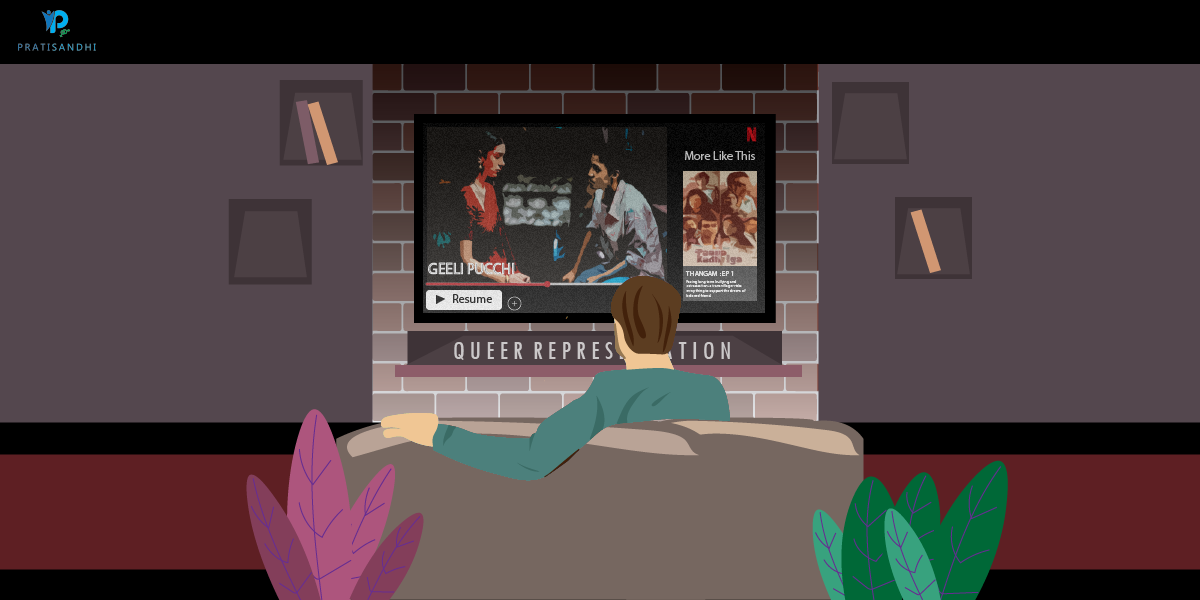
Representation Of Queer Identities On OTT Platforms
Cinema is a reflection of society. With the ability to transcend physical space and time, it has proven to be a means of entertainment, learning, and escape. Hindi Cinema, also known as Bollywood, continues to be the world’s largest producer of films. The new online space, OTT (Over The Top) platforms is widely growing due to Covid-19 lockdown and its experimental, fresh narratives. It holds the power to influence people and also gives public visibility to marginalised communities. It can conform or subvert the dominant culture. This article discusses the Queer Representation on OTT platforms and its impacts on viewers.

Geeli Pucchi from Ajeeb Dastaans
In the Netflix anthology Ajeeb Dastaans (2020), the short story Geeli Pucchi explores the lesbian relationship with an intersection of class, caste and gender. Bharti belongs to the Dalit community whereas Priya is a married woman from an upper caste, Brahmin family. Through Priya’s constant reminiscence about her childhood friend, Kavita, and a video on Bharti’s phone, their hidden sexualities come across.
Their relationship blooms but takes a rough turn when Priya comes to know about Bharti’s caste. Priya terminates their relationship because of the caste differences. A loving husband and motherhood don’t satisfy Priya because of her repressed sexuality. She is confused and feels that, because of the heteronormativity, the problem lies within her which needs to be treated. Bharti believes that being a lesbian is natural and not a disease. However, she tells Priya that motherhood is the solution to her distress.
Without any mention of the terms ‘lesbian’ or ‘homosexual’ throughout the film, the complexity in accepting and embracing one’s sexuality is visible. Through Priya’s character, we understand that conforming to the heteronormative idea might bring respect and status in society, but it doesn’t bring happiness and satisfaction that every individual seeks within.
Thangam from Paava Kadhaigal
Set in the 1982 Kovai district, Sathaar is a transgender who is subjected to ostracization, ridicule and harassment. The patriarch of the house, Sathar’s father constantly abuses him for bringing shame to the family. Villagers are fearful of his identity and refrain from touching him. Because the transgender identity doesn’t fit into either binary dichotomy, they were criminalized during British rule. Even after independence, the stigma remains prevalent. As shown in this short movie, the stigma eventually kills Sathaar. Not only transgender, but queer identities face oppression from societal institutions such as family, law, religion, etc.

Impact of Queer centric movies
A research survey has been conducted as a part of the writer’s academic semester with 50 participants. The survey aims to determine the impacts of Queer-centric movies on the perception of its viewers as well as explore its representation and consumption on OTT platforms. The participants ranging from the age group 18-50 showed that 48% consume OTT platforms for less than 1 hour, 40% consume 1-3 hours, 8% consume 3-5 hours and 4% consume more than 5 hours per day. This accounts for the growing consumption of OTT platforms.
The COVID-19 lockdown has also made a huge impact. During the lockdown, both ZEE 5 and Amazon prime (in the third quarter internationally) witnessed an 80% increase in membership; Netflix reached 16 million users in three months; MX player registered 141 million visitors and Sony LIV reached 26.14 million visits in December 2020 (Jain, 2021).
The OTT platforms differ from television shows and mainstream cinema because of their content quality and freshness. Going beyond the conventional tropes, their content experiments and explores new narratives. It ensures fresh content full of entertainment and awareness of socio-cultural, political issues.
Above mentioned research survey also determines the before-after impact of watching queer-centric movies. Accordingly, it shows an increase from 72% to 84% who believed it was natural; 70% to 94% who believe they have the right to marry; 74% to 96% believe they have the right to adopt; 80% to 92% agree they are discriminated against in several ways; 86% to 94% believe society must be inclusive and respectful of queer identities; 64% to 98% advocate for LGBTQIA+ rights in any manner they can. Such movies have helped 20% of participants come out of the closet. It also revealed that a majority of 36% didn’t receive any sex education at all. A subsequent majority of 28% claimed the sex education provided was relevant to their gender identity only to some extent.
Sex education in India has met with several obstacles from government and leaders. Because of limited access to information on sexual and reproductive health, there are myths and misconceptions around it. When there is insufficient or a lack of sex education, people resort to other sources like the internet and movies for information. False information misguides and adds stress. Misrepresentations as seen in Laxmi (2020), Dostana, Kal Ho Na Ho, Raja Hindustani (1996), etc stereotype queer identities. Therefore, introducing and implementing Comprehensive Sex Education programs is a must.

Conclusion
Other Indian OTT movies and series that portray authentic representation include Aligarh, My Brother Nikhil, Margarita with a Straw, Super Deluxe, Bombay Begums, and Made in Heaven. The mentioned research concludes that these movies have impacted the perceptions of Indian society in a positive manner. It is bringing awareness and helping normalize queer identities. It helps people explore their sexuality and deem it natural, and not a punishable sin.
Media, being a powerful tool, must realize its potential and create narratives that further normalize and portray the complexity of embracing one’s sexuality within oneself and in society. Though movies help people explore their sexuality, they can not be considered a substitute for sex education. Sex education in schools is imperative so youth can navigate their gender identity, sexual, reproductive experiences safely.
Cover Illustration: Alfia
Author

